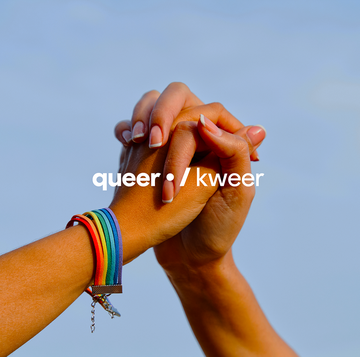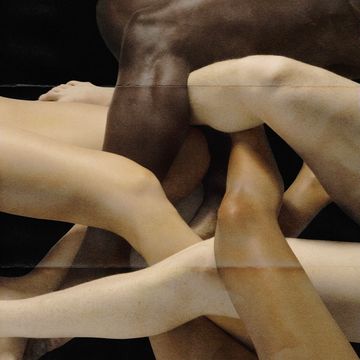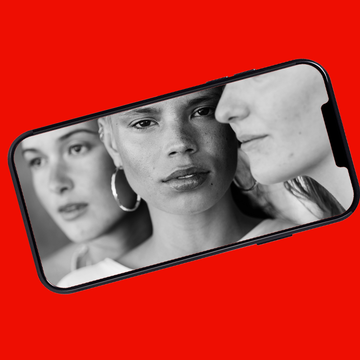When learning about affirming language, you may be eager to know the definitions for certain gender identities like neutrois. But trans advocate Micah Rajunov (he/him), coeditor of the anthology Nonbinary: Memoirs of Gender and Identity, says that the dictionary definition of neutrois isn’t super relevant.
“There is no one definition. Each term we use to describe gender is pluralistic and individualized—just like our genders are,” says Rajunov.
While there’s no one specific definition and it can look different for everyone, Rajunov points out that for him, neutrois is a gender identity that aligns with a gender that is “neutral” or agender (meaning a person who does not have a gender).
And while some people express or embrace aspects of masculinity and femininity, Rajunov says the term “neutrois” can mean not embracing either.
What does it mean to be neutrois?
According to Neutrois.com, a site Rajunov admins, neutrois is a non-binary gender identity that often falls under the genderqueer and/or transgender umbrellas.
“The definition I’ve seen most associated with neutrois is a non-binary gender identity where one’s gender is neutral or ‘null,’” says Naomi Cruz (they/them), coordinator of online programming and family programming at Gender Spectrum, a national organization creating gender-sensitive and inclusive environments for children and teens.
“This identity doesn’t necessarily imply that all of one’s gender is neutral or null, but at least parts of one’s gender is neutral.”
Per discussion on Tumblr, the term was coined by H. A. Burnham (ze/hir) in 1995, to describe hirself as a nongendered class, and other people with feelings of gender absence and resulting misalignment.
The term was incredibly popular on Tumblr in the 2010s—and actually, the Tumblr page GenderGueerID.com still has lots of archived posts on what it means to be neutrois that you can read today.
What’s the difference between neutrois, non-binary, transgender, and agender?
As Cruz explains, there’s a lot of overlap between neutrois, non-binary, agender, and transgender. While some people may use these terms for themselves interchangeably, they can also mean different things to different people.
Non-binary
Per Cruz, “non-binary” is an umbrella term that encompasses any gender identity that is not strictly “man” or “woman” and does not exist within the man/woman gender binary. This can include neutrois people, agender people, and/or gender fluid people.
“Neutrois is an identity that falls under the non-binary umbrella, and some people who use the neutrois label may also use the non-binary label,” Cruz says. “However, some people are strictly non-binary as well.”
In other words, non-binary is both a broad category and a singular identity. Under the tree of non-binary, there are lots of gender identities, yet someone can also just be non-binary.
Transgender
As Rajunov and Cruz explain, generally speaking, there’s a common misconception that transgender people transition or want to transition from one binary gender identity to another.
However, the word “transgender” can also be used to describe someone who feels disconnected from the gender they were assigned at birth and/or someone who is a non-binary gender (like non-binary, agender, gender fluid, neutrois, etc.). Those who are non-binary, agender, gender fluid, and/or neutrois may call themselves transgender.
But keep in mind that “not all neutrois individuals are comfortable with others calling or referring to them as ‘transgender,’ so it’s always best to ask the individual,” says Cruz.
Like the gender identity non-binary, “transgender” can be both an umbrella term and a personal identity. There are lots of transgender identities, but transgender can also be used as an identity itself.
Agender
Cruz says that the term “agender” refers to someone who does not have a gender or is genderless. “Some individuals who are neutrois also use the agender term, some do not,” says Cruz. “The most important part to remember is that gender is fluid and identity terms do not carry meaning until an individual gives them meaning.”
What does neutrois look like?
First and foremost, like all gender identities, there is no one way to dress or present as neutrois. “What being neutrois means to one individual could be entirely different than what another individual feels, and that’s okay,” says Cruz.
While some neutrois people only use they/them pronouns or neopronouns like ze and zir, some neutrois people might use she or he pronouns. Some neutrois people might dress or groom in a more “neutral” or androgynous way, and others may present more “feminine” or “masculine.”
“It all depends on the individual, but all forms of expression are valid for people who use the neutrois label,” Cruz says. “Ultimately, what matters most is that an individual presents and acts in the ways that make them feel affirmed and comfortable.”
Cruz continues that some neutrois people pursue medical transition—like having top or bottom surgery—or other gender-affirming surgeries. And in addition to medical transition, Cruz shares some neutrois people may socially transition. According to Planned Parenthood, this means they may come out as neutrois to friends and family, ask people to use correct pronouns, go by a different name, and dress or groom in way that makes them feel comfortable and valid.
“Transitioning can be a really valid and important piece for a neutrois individual to find gender euphoria or comfort,” Cruz says. But of course, other neutrois people will never medically or socially transition, which Cruz emphasizes is also valid.
Signs you could be neutrois
Because gender identity and expression is so personal, it’s impossible to provide a list of “signs” or “evidence” that you may be neutrois. However, if you’re questioning your gender, feel limited by expectations related to the gender assigned to you at birth, or just uncomfortable about gender, you may be non-binary or neutrois.
Cruz continues that if you feel disconnected or uncomfortable being viewed or treated as a “man” or a “woman,” it could be one indicator that your gender is not binary.
“If you don’t feel ‘masculine’ or ‘feminine’ or you feel like your gender is neutral, then neutrois might also be a good fit for you,” they say.
Reflecting on his personal experience coming out at neutrois and then later as non-binary, Rajunov explains how the neutrois label resonated with him. “I was not female and I was not male and I wasn’t both. I was neither,” says Rajunov.
What to do if you think you’re neutrois
If you’re questioning your assigned gender or think you may be neutrois, Cruz suggests being patient and calm with yourself and asking yourself these questions:
- Are you happy or comfortable with your assumed gender identity?
- Do the pronouns or names people use for you make you happy?
- Would other pronouns or names make you happier or more comfortable?
- Have you ever thought that you were not the gender you were assigned at birth?
- Do you ever wish that you were born as another gender or that you had no gender?
“Discovering one’s gender identity involves stepping back from the gender label society pins on you and asking yourself how you feel most comfortable with your gender,” Cruz says.
While you may not be interested in finding a single word or label that describes your lived experience, Cruz notes that many individuals may feel relief or comfort when they find a term that fits. “I believe that if a gender identity term feels comfortable or like the best fit for someone, then that person may be that gender identity,” they say.
In addition to self-reflection, Cruz suggests reading about what it means to be neutrois on the Nonbinary Wiki or Gender Wiki, to develop language and see if the term is right for you.
Resources for neutrois people
Navigating your gender can be confusing and isolating. But Rajunov and Cruz emphasize that if you think you’re neutrois, you’re not alone. There are a number of community resources and internet spaces to connect with other neutrois and non-binary people to learn about their experiences as well.
Cruz recommends looking for gatherings of non-binary and neo-gender people online on Tumblr, TikTok, and Discord. Searching for hashtags like #neutrois and #nonbinary can help you find others too.
Rajunov suggests looking at AminonBinary.com as well as attending his workshop on Nonbinary Transition, which addresses the complexities of what transition means (or doesn’t mean) to different people.
Rajunov’s own website Genderqueer.me and Neutrois.com both host a collection of transgender and non-binary resources, including lists of affirming health care specialists, digital and IRL groups, and workshops about gender.
Genderqueer.me runs a series called Featured Voices where non-binary and gender-expansive people write about their own experiences. Rajunov’s Nonbinary Memoirs also contains 30 personal stories about diverse experiences with gender. Additionally, Gender Spectrum has a number of groups and resources for gender-inclusive education.
Cruz also notes that learning how to express yourself and setting boundaries and expectations with your friends and family is important but can take a while. You get to decide who you want to come out to, how you want to come out, and what type of language feels right in what spaces.
“This may look like having set rules on what name, pronouns, and other terms someone can use for you are, but it can also include boundaries around what someone can ask about your gender, including not having people ask you about your genitals or what you were assigned at birth,” Cruz says.
How to support friends or partners who are neutrois
If a loved one is coming out as neutrois or any non-binary gender, Cruz suggests educating yourself on the language and terms so your loved one doesn’t have to do the work for you. This takes the pressure off your loved ones to do extra labor and lets them know you’re invested in making them feel safe.
“Beyond that, my biggest piece of advice is listening to their friend, relative, or partner,” Cruz says. “Neutrois has a general definition, but each individual has their own understanding of that definition and may feel affirmed in different ways.”
Being a good ally (and also just a good person) means using someone’s correct name and pronouns, not asking inappropriate or invasive questions about their body or medical history, and letting them take the lead in opening conversations about their gender.
“If an ally or partner is cisgender or not non-binary, they may never fully understand what it means to be neutrois or non-binary, so it’s incredibly important that they listen to and trust the neutrois individual,” Cruz says.














